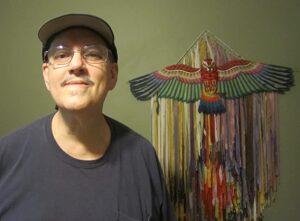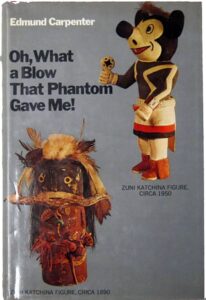 Tobias Mostel
Tobias Mostel
Born in NYC in 1948 of an entertainment family, Tobias Mostel started at the top: the Boys Chorus at the Metropolitan Opera. He received his BA in 1975 from the School for General Studies at Columbia University, and after a thirty-five year pause, his Master’s Degree in Humanities from FSU. An independent scholar, artist and musician, he lives in central N.Y. state.
Recently, the Metropolitan Museum announced that it will add Native Art to its American Wing for the first time. This is a travesty, an insult to Indigenous artists, and a trivialization of the disgusting history of Americans toward the Indigenous ever since Europeans arrived on ‘American’ shores in the 15th-century.
Let us not forget that it was the European colonizers who later became Americans, who ran roughshod over the Indigenous, and depending on what part of the country they settled in, they either embraced the Indigenous as trading partners, or sought, like the Massachusetts Calvinists, to exterminate them, due to their non-Christian and savage proclivities.
The Met Museum should not be the place where contemporary notions of nationhood are imposed on artefacts of a past that can have nothing to do with nationhood as established from the 18th century on. An Indigenous American piece is no more American than Stonehenge is English, or Angkor Wat is Cambodian. (Angkor Wat was built by the Khmer King Suryavarman II in the 1100s. During that time and up until the 20th century, the temple complex was in Siam, or Thailand. If history is to be the guide, then Angkor Wat should be on the Thai flag, not the Cambodian flag. But nationalism combined with nationhood knows no boundaries and recognizes no history other than the desired fictive history of the leaders). At the heart of the problem at The Met is the projection of contemporary nationhood, and nationalism onto earlier cultures that are manifestly not part of the contemporary nation, and cannot be so, by any stretch of the imagination.
The Indigenous of the ‘American’ continent probably arrived by the Bering Sea land bridge about 15,000 years before the Europeans. But the Europeans got to name the land without regard to those who occupied it already. The Indigenous, over the thousands of years that they lived in the land, had brought their culture with them. They worked in their symbolic images for thousands of years before their culture was impacted, often with force, by the Europeans. After repeated contact with the European/Americans, the Indigenous found their old symbols to have less meaning.
So they incorporated new symbols taken from the culture that surrounded them: American culture of the 1950s, as in the doll on the right. The Katchina Doll of the 1890s shows the usual features of tribal sculpture, a non-realistic whole with a hairy headpiece, staring eyes, a wrapping painted on and decorated with string or hide. The Katchina from the 1950s could conceivably be called an American object, fit for the American Wing, insofar as it shows Mickey Mouse, as American a symbol as possible (Disney). The Zuni Indian who coopted Mickey Mouse used this image because the traditional symbols used by his tribe no longer meant anything, and no one remembered how the symbolic system worked. The use of Mickey Mouse is a good example of assimilation of one group into an over-culture. In some quarters, assimilation is perceived as a variety of attack on the supposed pure constitution of a native. In other quarters, there’s nothing warlike about assimilation, but just because assimilation is a possible end result doesn’t mean that force cannot be used while assimilation takes place.
American attacks on the Indigenous continue: witness the Trump administration’s plan to mine in Utah’s Bears Ears Monument, the Dakota Access Pipeline débâcle, Wounded Knee (1973), and many other attempts to deny, degrade and destroy Indigenous sacred sites, homes and businesses. Not only have Americans committed genocide against the Indigenous, Americans have represented the Indigenous as shifty, drunken, violent, stupid, sex-crazed, and simple-minded. If Indigenous art were taken seriously, there would be distinctions among the sacred art of the tribes, the post-contact work and the stuff the tribes manufactured for tourist souvenirs. No such distinction is made in the Diker Collection, for example. In the collector’s fatuous statement ‘we always felt that what we were collecting was American art, and we always felt very strongly that it should be shown in that context’ (artnet.com 3/10/17) lies the serious error of lumping all things into one thing. This is like saying that because Monet made some pictures in London, he was an English artist. Indigenous souvenir art is certainly American art, but sacred tribal art is not.
The Met, in the past, has made distinctions between serious art and kitsch of the European variety. In contemporary American art, such a distinction is meaningless, as most of it is kitsch, indeed it wallows in kitsch, and everywhere it is proclaimed that kitsch is as good as the Mona Lisa. Such problems of taste, aside Indigenous art isn’t kitsch, except for the souvenir stuff. I would not object if the souvenir art of the American Indians were shown in the American Wing – indeed the Indigenous who make such stuff, are surely as American as the people who make little alligators or Donald Duck mugs for mass consumption. But there is a sacred art. This is not for mass consumption; it is for contemplation. While the value of contemplative art is routinely denied by the post-modernists and their devotees, the fact is that contemplative art has been produced by humans for all of history; it has been valued for all of history, and it has been perceived as the highest achievement of humankind everywhere except, perhaps, in contemporary America.
Sarah Cascone of artnet.com says in a subheading of her article on the subject, ‘Indigenous art finally takes its rightful place in American art history.’ Its ‘rightful place’? Indigenous sacred art has no place, rightful or otherwise in the largely derivative collections of the American Wing. It should be remembered that early American art is colonial art, dependent on what the mother country was doing: first Dutch, then English, ad nauseam. Later American art, from the early 20th century on, struggles for its identity for almost a half a century before that identity was forged by a batch of hard-drinking Yanks and some European transplants. If the context for the Indigenous art were pictures of genocidal horrors, disruptions of sacred landscapes and a trampled, often defeated people, perhaps I would not object to its presence, but in the American Wing, such representations of history would no doubt be ignored, because the superior position of paternalistic benevolence routinely ignores such context.
For shame, Met Museum! A museum like the Met is a repository for things that have been classified, separated, and stacked according to a theory of cultural continuity or historical importance. Putting Indigenous artefacts in the American Wing is like putting post-war German Jewish art in the Führermuseum in Linz, (had it been constructed). Now the Indigenous art will service the guilt and greed of the overclass that brought about the destruction of native culture, art and lives in the first place.
While I agree that Indigenous art should be in a museum, it shouldn’t be in the American Wing. After all, the Met Museum is a monument to all things that Indigenous art isn’t. Let the art breathe somewhere else and let the American Wing continue to wallow in its would-be cultural superiority and in its desire to claim equality with everything European. The American Wing is a celebration of the annihilation of Indigenous art. Indigenous art should not be a doormat for either European or American supremacy over Indigenous existence.
